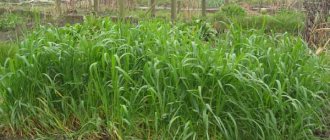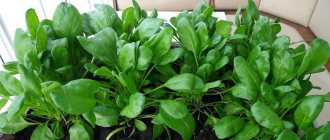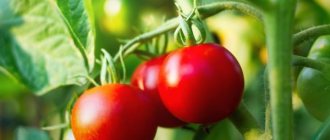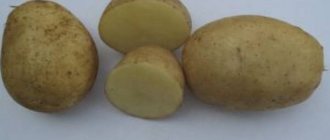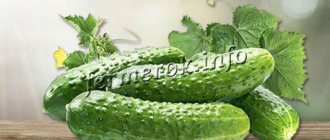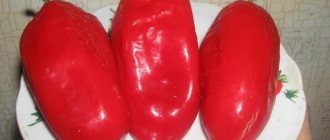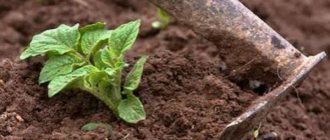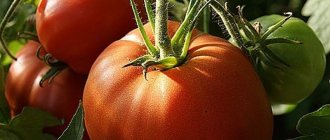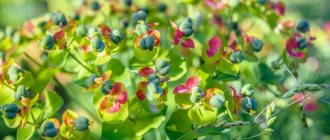Description of spinach-raspberry
Spinach-raspberry grows wild in many countries, mainly in mountainous areas and foothills. There are 2 main varieties of strawberry spinach. This is the multileaf goosefoot, whose homeland is Southern Europe, Asia, New Zealand, as well as the capitate goosefoot, which was first discovered in North America. The species differences between them are minimal. A photo of a branch of strawberry spinach is shown below.
The main characteristics of strawberry spinach are given in the table below:
| Parameter | Meaning |
| Type | Annual herbaceous plant of the Aramantaceae family |
| Synonymous names | Strawberry Beetroot, Indian Ink, Strawberry Sticks, Goosefoot Strawberry, Goosefoot, Common Zminda |
| Appearance | Compact bush up to 0.8 m high |
| Stems | Green, straight, ribbed |
| Leaves | Diamond or triangular, arrow-shaped, corrugated, bright green |
| Flowers | Numerous, small, ripen in the axils of the leaves, grow together as they mature |
| Berries | Drupes of fused flowers, up to 2 cm, bright red |
In appearance, strawberry spinach berries more closely resemble raspberries rather than strawberries. They reach full maturity a few months after emergence. At this time, they become soft and wrinkle easily, making them difficult to collect.
Spinach, strawberries or something else?
“Strawberry spinach” sounds quite tempting. So to speak, two in one. But in fact, this plant is nothing more than polyfolia. Another name is common zhminda. It belongs to the Amaranth family and the Chenopodiaceae subfamily. In southern Europe and northern Africa, pigweed grows mainly as a weed. The plant is cultivated in a few countries, for example in the Netherlands. Some people mistakenly consider strawberry spinach to be quinoa, which, by the way, was previously cultivated. But these are two different plants, although they belong to the same family. Mary is not as unique as advertised, but it can be cultivated. It has useful properties, but there is little hassle in growing it.
Varieties of strawberry spinach
There are few varieties of strawberry spinach. This is due to the limited use of this vegetable in cooking. Selection work in this direction was not purposefully carried out. In most agricultural firms and stores, there is usually no mention of the varieties of this plant; the seeds are sold under one name. In some sources you can find mention of strawberry spinach varieties Strawberry Sticks, Grilyazh, Victoria and some others, which were grown by gardeners in the Russian Federation. However, practice shows that there are practically no varietal differences between them.
Botanical description: flowers
Chenopodium capitatum, also known as Beetroot and Strawberry Spinach, Strawberry Blite, has some attractive traits. The small, spherical flower clusters (up to ½ inch) are green when ripe but soon turn bright red. These numerous flowers are densely packed in round clusters in the uppermost leaf axils and twisted around the upper stem. At the peak of flowering, they form clusters up to 3/8 inch in size.
Flowers have no petals. They have 3 short stamens surrounding an oval green center with a tiny 2-sided spire at the tip. It soon turns brown. At the base of the flower there is a green calyx with three elongated lobes less than 1 mm long. Strawberry spinach flowers are hermaphrodites (have both male and female organs) and are wind pollinated.
Beneficial properties of strawberry spinach
In addition to culinary properties, the plant also has many beneficial properties. It contains the following elements:
- Oxalic acid.
- Vitamins A, B1, B2, C, PP, E, K, N.
- Beta carotene.
- Microelements (magnesium, calcium, iron).
Strawberry spinach is a good source of protein. Its content can reach up to 2.9% of the total mass of the plant. In addition, the plant has a low calorie content, only 22 kcal.
The rich content of nutrients makes it possible to use strawberry spinach for medicinal purposes. It has a good effect on the cardiovascular system, normalizes digestion and metabolism. Consumption of this vegetable also has a beneficial effect on reproductive function, increases potency, and reduces the risk of rickets, scurvy, and tuberculosis. Eating spinach normalizes pregnancy in women and strengthens the immune system.
Attention! The beta-carotene contained in spinach has a good effect on the skin, improves its appearance, nourishes and smoothes out wrinkles. Therefore, the plant is often used for cosmetic purposes, adding to nourishing masks.
Advantages and disadvantages
Like all other garden plants, crimson spinach has its pros and cons. The indisputable advantages of this type include:
- unpretentiousness in cultivation;
- fast growth and good cold resistance;
- beneficial features.
In addition, it is worth noting that all parts of the plant are considered edible. There are also disadvantages to healthy spinach. The main disadvantage is that the crop quickly spreads throughout the area and can crowd out other plantings.
Important! Berry spinach is not recommended for people suffering from stomach ulcers, gout and intestinal diseases.
Spinach-raspberry fruits are edible, but you should be careful with the seeds inside them, they are toxic and should not be consumed
Strawberry Spinach Recipes
The berries of this plant are used as one of the components of pies filling, they can be used to decorate salads. Often, colorless compotes or tinctures are colored with strawberry spinach berries. Despite the name, the fruits have virtually no taste or aroma, so they are practically not used in their pure form. The sweetish taste appears in the berries only when fully ripe. Dried fruits are used to make vitamin tea. Here are some recipes that you can use strawberry spinach in:
- Kvass. To prepare, you will need 1 liter of strawberry spinach berries, 2 liters of warm boiled water, 500-750 g of sugar. Do not wash the berries, mash them thoroughly and add water. Add sugar, mix well, pour into a bottle and put in a warm place. The yeast contained in the berries will begin to ferment the prepared wort. After about 3 days, the finished kvass can be drained from the sediment, filtered and stored in a cool place.
- Jam. Since strawberry spinach berries are practically tasteless, they can be used as a vitamin supplement to any other jam. Or vice versa, add other ingredients to the spinach jam, with a more pronounced taste and aroma. To prepare the base, the syrup, you need granulated sugar and water in equal proportions. They are mixed and brought to a boil. Then spinach berries are poured into the syrup. The resulting mixture is brought to a boil, then removed from the heat and allowed to cool for 12 hours (or overnight). The procedure is repeated three times. The finished jam is poured into jars, sealed and stored in a cool place.
- Salad. To prepare various dishes, you can use not only the fruits, but also the leaves of strawberry spinach. For the salad you will need a bunch of green young leaves, 2 tbsp. l. sesame seeds, 1 tbsp. l. sake and 1 tsp. sugar and soy sauce. Sesame seeds must be crushed in a blender, then added to the spinach. Mix the remaining ingredients and season the salad.
Leaf Recipes
Many people use strawberry spinach as the first spring green. Reviews here are also mixed. Some people find the leaves of the plant tasteless, so they add something else to the salad with them, for example radishes.
Hot salad
Chop 1-2 onions and a couple of cloves of garlic and lightly fry in sunflower (or olive) oil. Wash the spinach leaves, chop finely, place in boiling water for 2 minutes and drain in a colander. Add cooked leaves, finely chopped canned olives, spices, salt to the onion and garlic in a frying pan and simmer, covered, until tender. You can add a beaten egg at the very end of cooking.
Pie
Wash the spinach leaves, cut them and place them in boiling water for 2-3 minutes, drain them in a colander and place them in a bowl. Finely chop the onion and fry in oil. In a bowl with the spinach, add the prepared onion and some salty cheese, pre-chopped (preferably Greek feta, but you can also use our cheese). Roll out the puff pastry into a thin layer and divide into two parts. Place the prepared filling on the first one, cover it all with the second one, seal it around the edges and place it in the oven. Bake until done.
Contraindications
The beneficial effect of eating strawberry spinach is significant, but the increased content of oxalic acid in the plant also has the opposite effect. Saponin, synthesized in leaves and fruits, is a toxic substance. Therefore, eating strawberry spinach leaves or fruits in large quantities can cause intestinal disorders.
Warning! The use of this plant is contraindicated for people with diseases of the urinary tract, digestive organs, ulcers, and those suffering from gout.
Secrets of experienced gardeners
There are several interesting facts about strawberry spinach that you need to know when growing it.
These secrets will help you properly care for the plant and not get another weed on your plot:
- If you want strawberry spinach to grow in a certain area, you need to pick the seeds and plant them yourself every year.
- If you do not want to constantly collect seeds, you can place the plant in a ventilated greenhouse so that the seed material does not spread beyond its perimeter.
- The leaves and seeds of the plant contain saponins. These are toxic substances, but they are completely safe for humans in small quantities. When thermally processed in cooking, they completely disintegrate. However, health problems may arise if you eat too many raw berries.
- Oxalic acid reduces the value of products. Therefore, it is necessary to add the plant to food in moderation.
- The taste of strawberry spinach is not the best; flowering also brings little pleasure to gardeners compared to other flowers. But the nutritional value of the berries and leaves makes many people grow it.
- If the plant becomes too numerous, you can get rid of it by uprooting it. The root system is not very developed, so you can dig it up.
- Thus, strawberry spinach can be a good antioxidant and medicinal when used correctly. But if abused, it is a toxic substance. The berries can be used in preparations for the winter. Leaves that can be frozen can be used in cooking during the cold season.
Features of growing spinach-raspberries
Strawberry spinach can be grown without any problems in the Central, North-Eastern regions of Russia and further south. The plant is unpretentious, does not require special care, grows on any type of soil, and easily tolerates frost. Can be grown both in open ground and at home.
Often there is no care at all; strawberry spinach reproduces well by self-sowing. In this case, the crop can easily turn into a weed and will have to be dealt with.
Origin: general information
Strawberry spinach is native to North America. It grows wild throughout the northern part of the continent, in open foothills, mountainous and subalpine regions. Considered endangered in some US states.
The scientific name of this curious plant is Chenopodium capitatum, which is Latin for capitate pigweed. The plant is popularly known as “strawberry sticks” or “strawberry spinach”. Growing this edible herbaceous plant is of interest to many gardeners. That is why the annual plant is so popular in New Zealand, Canada, and is common in Alaska and Europe. Its favorite habitat is sand dunes and calcareous soils. The plant prefers moist mountain valleys, open forests and flat areas.
Planting and caring for strawberry spinach
Planting and caring for strawberry spinach is not difficult. In some cases, sowing can be done only once; in the future, the plant will reproduce on its own. The plant is undemanding to its neighbors; it will grow well not only in a separate bed, but also next to peppers or tomatoes, in the aisles of carrots or beets.
Planting strawberry spinach
Planting strawberry spinach is done after the soil has warmed up sufficiently. You can use seed and seedling planting; the second is more labor-intensive, but allows you to get a harvest faster. The beds must be dug up in advance, adding additional fertilizer. It is preferable to use organic matter, rotted manure or humus.
Growing strawberry spinach from seeds
Strawberry spinach seeds must be stratified before planting by keeping them in the refrigerator for several days. This will increase their germination rate. After stratification, the seeds are soaked for half an hour in a weak solution of potassium permanganate for disinfection. The prepared seeds are sown in rows in beds to a depth of 1.5-2 cm. After this, they must be sprinkled with earth or sand. The bed needs to be watered and covered with film until shoots appear. It usually takes 10-12 days before the first shoots appear, then the cover must be removed. Seeds can also be sown before winter. In this case, fresh leaves can be picked already in May.
Growing strawberry spinach seedlings
You can sow strawberry spinach seeds for seedlings as early as April. It is preferable to use individual peat cups, this will avoid picking. Sowing is carried out to a depth of 1-1.5 cm. After this, the soil is moistened, and the cups are covered with film and put away in a dark, warm place. 10-12 days after emergence, the film is removed and the pots with seedlings are placed on the window.
After 4-6 full-fledged leaves are formed on the plants, they can be transplanted into open ground.
Watering and fertilizing
Strawberry spinach does not tolerate dry soil well, so it is necessary to moisten the soil regularly. It is best to water at the root, in a thin stream. The plant does not require fertilizing. In spring, the bushes can be fed with infusion of ammonium nitrate, this will enhance the growth of green mass. In the future, it will be enough to fertilize with an infusion of ash or a solution of complex potassium-phosphorus fertilizer.
Weeding and loosening
When planting using seeds, weeding should be approached especially carefully. From the moment of planting until the first shoots appear, 1.5-2 weeks may pass, during which time the weed can grow significantly and is guaranteed to choke out weak spinach sprouts. After the emergence of seedlings, it is better to mulch the beds with peat or humus. This will not only serve as a deterrent to the growth of weeds, but will also ensure the preservation of moisture in the soil.
Protection from diseases and pests
The appearance of diseases on strawberry spinach is quite rare. This may only be due to the neglect of plantings or unfavorable weather conditions. Most often, fungal diseases may appear on plants in the form of spots or plaque on the leaves. In this case, the affected plant should be destroyed. Insect pests practically do not appear on strawberry spinach. They are not attracted to tasteless fruits and leaves with a high content of oxalic acid.
Video about growing spinach-raspberries:
Growing on a windowsill
If you need early greens for salads, then sow the seeds in pots from March to April and grow them as seedlings or indoor flowers. You can make the soil yourself from soil from your site and humus or compost (1:1). Another option is to collect soil from under the turf in a forest or clearing. It is fertile and has a loose granular structure. Purchased soil is also suitable - universal for seedlings or vegetables.
Soddy soil has a loose structure and contains humus, a product of the processing of plant residues by earthworms.
Purchased soil has ceased to be a panacea for me. There are a lot of companies involved in its production and sale. According to the principle “the land is the same in Africa, how can anything not grow on it,” I bought the cheapest one for seedlings. Inside the bags, in addition to soil, there were pieces of shovel cuttings and lumps of clay. As a result, half of this “land” had to be thrown away. But the worst thing is that the seedlings did not grow in it. The seeds sprouted, 2-3 leaves appeared and things didn’t go further. Now I have a different principle: my own is best, no matter what kind of land we have on our site, but everything grows on it. And I’m afraid to advise everyone to buy ready-made soil after this. It’s better to pick it up somewhere in the wild from under the weeds, but you will know for sure that the earth is alive, plants grow on it.
To grow at home, be sure to disinfect the soil. Wherever you take it, among the lumps there may be eggs of aphids, mites, whiteflies, and disease fungi. These parasites will multiply on all your indoor flowers and seedlings. In warm conditions, the full life cycle from emergence from the egg or mycelium to the ability to reproduce lasts only 5–7 days. That is, every week hundreds more individuals will be born in addition to the existing ones. It will be difficult to get rid of. Therefore, it is better not to take risks, but to warm the earth to 100 ⁰C. The easiest way is to pour boiling water. Give the soil 3-5 days to dry and recover and begin sowing strawberry spinach.
Video: methods of disinfecting soil for seedlings
On the page of the English online store Suttons, in addition to the description of Strawberry Sticks, there is also a growing technology:
- Take a tray or container with drainage holes and fill it with fertile soil.
- Water and place the seeds on top.
- Sprinkle with a thin layer of soil and wait for shoots. They should appear in 7-13 days.
- As soon as the plants grow, place them in different pots.
- Grow on a warm and well-lit windowsill.
- At the end of spring and summer, place the pots outdoors and bring them indoors at night.
- At the end of May - beginning of June, plant it in a sunny place in the garden or in a large pot, flowerpot, or flower bed.
This is what strawberry spinach seedlings look like
As it grows, you can pick a few leaves for salad. The berries will appear in late summer and are best eaten fresh. If you grow it in a pot until the end of the growing season, then its volume should correspond to the size of an adult bush: the height of the shoots is 40 cm, which means that the diameter and depth of the container should be the same. The soil in flowerpots and open-air containers dries out faster than in the garden bed; be careful not to skip watering. The soil should be constantly moist, but not soggy. Feed in the same way as in open ground.
Strawberry spinach for early greens can also be grown in a greenhouse along with radishes and salads. Do sowing as soon as the ground thaws. With the onset of warmth, plant the grown bushes in open ground, making room for heat-loving plants: cucumbers, tomatoes, melons, watermelons, peppers. By the way, in this way crop rotation is carried out, which is necessary for greenhouses in which one crop is constantly grown.
Harvesting
The concept of “harvest” is quite difficult to apply to strawberry spinach, since all its parts are edible. Young greens for preparing salads can be picked before flowering; later they become tough and bitter, although they do not lose their beneficial properties. From August the fruits begin to ripen on the bush. Even though they are bright red, this is not a sign of ripeness. The fruits become fully ripe only in the fall. By this time, they acquire a dark burgundy color, become soft and wrinkle easily. At this time, sweetness appears in their taste.
Such berries are cut along with the stem and then carefully separated.
Pest Control
1- Root rot 2- Aphids 3- Whitefly
Strawberry spinach is almost not susceptible to pests.
However, the following problems may occur:
- Root rot , which appears due to high soil moisture. It is necessary to stop watering for a while and add quicklime to the soil at the rate of 150 grams per 1 square meter of land.
- Aphids or whiteflies may attack leaves. If you do not plan to use the plant for food, then you can use modern poisons. If the leaves and berries are used in cooking, then you need to use a soap solution until the pests completely disappear.
Thus, if you want to decorate your summer cottage with a beautifully growing weed that has a number of useful properties and can be used in preparing various dishes, then you should purchase strawberry spinach seeds. However, this name is not always written on the seeds. It can also be raspberry spinach. And some honestly write pigweed, since this plant is indeed a relative of quinoa.
Features of application
Strawberry spinach leaves are used in various fields. Most often it acts as an ornamental plant to decorate rooms or areas. The plant is also used by doctors to treat various diseases, cosmetologists for facial rejuvenation, and culinary specialists to prepare healthy and tasty food.
Spinach is used to decorate the garden. The bright and beautiful fruits of the plant can be kept on the branches during June - September. Therefore, decorative strawberries are often planted along paths as borders or unusual spots in flower beds.
Since the plant is easy to care for, it is often planted on alpine hills or in places where other plants cannot grow.
When treating various diseases, doctors often advise eating strawberry spinach. For example:
- the plant is rich in carotene, which prevents damage to arterial walls. Therefore, it is recommended to eat it for better functioning of the heart and blood vessels;
- thanks to vitamin C and beta-carotene, spinach protects the walls of the colon from the influence of harmful components, and also prevents constipation;
- with constant consumption of the plant as food, the functioning of the male reproductive system improves;
- doctors advise spinach leaves to be consumed by people suffering from anemia, anemia or tuberculosis;
- the plant helps with diabetes, high blood pressure and hemorrhoids;
- dishes with the plant remarkably strengthen the body’s defenses;
- The nervous system is also strengthened.
Experts recommend spinach during pregnancy to strengthen the immune system, as well as for older people to prevent the onset of prostatitis.
Strawberry spinach can be consumed in any form. Green leaves are used to create vitamin-rich salads and sauces. The foliage is also covered for the winter in the form of pickles or pickled products.
Red berries are often used to make compotes. They are frozen for the purpose of decorating confectionery or meat dishes.
Since spinach is low in calories, it is eaten as part of the diet. Dishes with strawberry spinach:
- Beat the eggs and add salt and pepper to taste. Add grated cheese (200 grams), spinach (500 grams), flour (45 grams). Mix thoroughly. Pour the resulting dough into a greased pan. Bake the pie for an hour at 180 degrees.
- Wash and dry the berries. Mix water and sugar in equal quantities. Boil the syrup. Add prepared spinach fruits to it. Bring to a boil and cool. The jam can be varied by adding other fruits. For example, to get an unusual exotic taste with sourness, add kiwi to your preparation for the winter.
- Pour 2 kilograms of plant fruits with warm water and add 2 kilograms of sugar. Cover the container with a lid and place it on the table. Let the kvass brew at room temperature for three days.
- To prepare soup with the plant, boil 500 grams of spinach and chop with a blender. After boiling the beef broth separately, divide the meat into pieces. Add 500 grams of chopped potatoes to the broth. When the potatoes are cooked, chop them directly into the soup. Add spinach puree to the soup, and after boiling, simmer for two minutes. To make the soup more tasty, you can prepare a dressing for it. Add a little lemon juice to sour cream (1 glass) and various spices to taste.
The listed dishes will appeal even to those who adhere to a diet. They have low calorie content, which is important in the fight against extra pounds or restoring health.
It is recommended to eat strawberry leaf salad fresh, but it should not be stored for longer than a day. If you eat prepared salad during the day, store it in a cool place. If spinach is kept warm, dangerous nitrogen-containing substances form on its leaves, which combine with the blood to form methemoglobin compounds. Such substances prevent the distribution of oxygen throughout the body.
Strawberry spinach contains beta-carotene, so it is often used to create masks and face creams. Products based on the plant have a positive effect on the skin, smooth it and reduce wrinkles.
To make a mask for rejuvenation, boil 100 grams of strawberry leaves in milk in an enamel saucepan. Place the resulting product on a thin cloth and apply it to the face and neck, avoiding the area around the eyes. After 20 minutes, remove the remnants of the mask and wipe your face with chamomile infusion. Preparation of a nourishing mask from the plant:
- Wash 100 grams of spinach leaves well and pour boiling water (100 milliliters).
- Wait until the foliage becomes soft.
- Cool and add carrot juice and honey, one teaspoon at a time.
- If desired, you can add olive oil in the amount of half a teaspoon.
After mixing the product well, apply it between layers of gauze. In this form, apply the mask to your face, neck and décolleté. After 10 minutes, rinse off the remaining mask with slightly warm green tea. After 5 minutes, rinse your skin with cool water and apply a moisturizing cosmetic.
Before using spinach masks to rejuvenate and improve the skin of the face and décolleté, it is recommended to consult with specialists, for example, a cosmetologist.
Now you know how strawberry spinach is grown from seeds, as well as what other growing methods exist. Since the plant can cure various diseases, it must be grown at home. If you follow simple rules for caring for spinach, you can get an ornamental plant to decorate your garden and paths in it.

